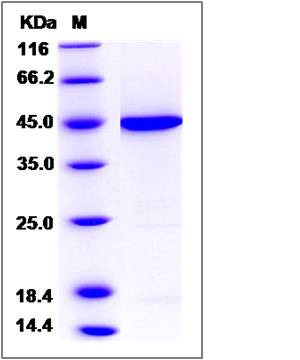Human Pleckstrin / PLEK / p47 Protein (His Tag)
P47
- 100ug (NPP2414) Please inquiry
| Catalog Number | P14401-H07E |
|---|---|
| Organism Species | Human |
| Host | E. coli |
| Synonyms | P47 |
| Molecular Weight | The recombinant human PLEK consists of 365 amino acids and predicts a molecular mass of 41.9 KDa. It migrates as an approximately 45 KDa band in SDS-PAGE under reducing conditions. |
| predicted N | His |
| SDS-PAGE |  |
| Purity | > 95 % as determined by SDS-PAGE |
| Protein Construction | A DNA sequence encoding the mature form of human PLEK (XP_004029394.1) (Met1-Lys350) was expressed with a polyhistide tag at the N-terminus. |
| Bio-activity | |
| Research Area | Immunology |Signal Transduction |Signaling Pathway |Calcium Signaling |Calcium Binding Proteins |
| Formulation | Lyophilized from sterile 50mM Tris, 10% Glycerol, pH 8.0. 1. Normally 5 % - 8 % trehalose, mannitol and 0.01% Tween80 are added as protectants before lyophilization. Specific concentrations are included in the hardcopy of COA. |
| Background | Pleckstrin is a protein found in platelets. Pleckstrin is the source of the name pleckstrin homology domain. Pleckstrin homology domain (PH domain) is a protein domain of approximately 120 amino acids that occurs in a wide range of proteins involved in intracellular signaling or as constituents of the cytoskeleton. This domain can bind Phosphatidylinositol lipids within biological membranes (such as Phosphatidylinositol (3,4,5)-trisphosphate and phosphatidylinositol (4,5)-bisphosphate), and proteins such as the βγ-subunits of heterotrimeric G proteins, and protein kinase C. Through these interactions, PH domains play a role in recruiting proteins to different membranes, thus targeting them to appropriate cellular compartments or enabling them to interact with other components of the signal transduction pathways. |
| Reference |
